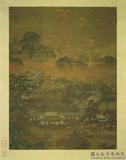清姚文瀚畫第二阿資答尊者 軸
推薦分享
資源連結
連結到原始資料 (您即將開啟新視窗離開本站)後設資料
- 資料識別:
- 故畫002859N000000000
- 資料類型:
- 類型:繪畫
- 型式:靜態圖像
- 著作者:
- 姚文瀚
- 主題與關鍵字:
- 宗教器用 鹿 瀑布 雲 大成就者
- 出版者:
- 數位化執行單位:國立故宮博物院
- 格式:
- 本幅 114.4x66.8公分、全幅 87公分
- 關聯:
- 秘殿珠林續編(乾清宮),頁365&*故宮書畫錄(卷八),第四冊,頁126&*故宮書畫圖錄,第十三冊,頁383-384&* 姚文瀚(活動於西元一七五二年前後),順天(北平)人。號濯亭,乾隆時供奉內廷,善畫佛道人物。 阿資答(阿氏多)尊者在西藏十六羅漢中,排名第二,奉釋迦牟尼之命,居住娑婆世界護持佛教。根據西藏說法,阿資答的加持立來自手印;凡供奉觀想他禪定手印的信徒,就能專注禪修,避免邪魔外力傷害。 尊者垂目入定,漢袍之外披袈裟,攏手趺坐於石台氈墊上。座前比丘揚手行藏式大禮拜,崖上畫藏式大成就者,束髮結髻,上身僅披禪定飄帶,揚鼓搖鈴,是古印度那爛陀寺的學者智吾巴。一位頭戴西藏遮揚帽的祖師,行走於雲端,比丘及花鹿追隨在後。人物雖然處於山水之間,此畫強調的卻非空間的理性結構,而是強烈的宗教本懷。 &* Yao Wen-han (sobriquet Cho-t’ing) was a native of Shun-t’ien (modern Peking). He excelled in Buddhist and Taoist figure painting and served as a painter in the Inner Court of the Ch’ien-lung emperor (r.1736-1796). According to the Tibetan tradition, Ajita is the second lohan. At the behest of Shākyamuni, he lives in Sahā-lokadhātu, the world of sentient beings, where he protects and maintains the Buddhist doctrine. Ajita’s eyes are lowered in a meditative trance. Over his Chinese-style robe, he wears a monk’s cassock. He holds his hands together and sits cross-legged upon a cushion on a stone platform. The monk in front of him throws his arms up in the Tibetan-style of worship. A Mahāsiddha, a saint or miracle-worker, painted in Tibetan style, sits on the cliff in the background. His hair hangs loosely over his shoulder with one look knotted on top of his head. He wears a meditation cord, beats a drum, and shakes a bell. This figure was originally the scholar Ghantāpada from the ancient Indian monastery, Nālandā. Above, a guru wearing a Tibetan sun hat walks in the clouds as a monk and deer follow him. &*1.葛婉章,〈清姚文瀚畫十六羅漢連作 — 清宮羅漢畫,流露西藏風〉,《故宮文物月刊》,第156期(1996年3月),頁50-72。
- 管理權:
- 國立故宮博物院
授權聯絡窗口
- 國立故宮博物院圖像授權、出版授權、影音資料授權-申請流程說明
http://www.npm.gov.tw/zh-TW/Article.aspx?sNo=03003061






